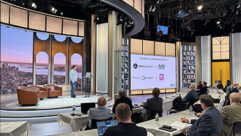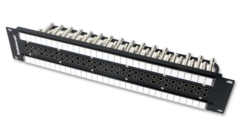Standardized Testing
Sep 1, 2001 12:00 PM,
Dean Rivera
HAVE YOU EVER TRIED COMPARING LOUDSPEAKER specifications from different manufacturers? If so you’ve probably exasperatedly wondered, “Is there a standard? Shouldn’t there be one?” Having a standard is especially a concern when looking at frequency response and power test specifications. This article will describe some of the loudspeaker test methods used to achieve the data for product specs. When you have gleaned some of the difficulties and inconsistencies in current testing methodology, read the Sidebars for a proposed standard test methodology — and why one is needed.
Comparing loudspeakers in side-by-side tests is the ideal method for selecting a favorite. You can hear the differences and decide right there which you prefer. However, if you are purchasing the loudspeaker from a catalog or Web site, then product specifications become a very important reference. But without a standard specification format, it’s difficult to know how the speaker was measured and if the information is accurate. Too often, data is inconsistent or incomplete, making direct comparisons between competitive products difficult or even impossible.
The most unfortunate aspect of inconsistent data is that customers often use the published product specifications to help with their purchasing decisions — without ever actually hearing the speakers. Marketing departments, of course, play up favorable specs and downplay others. Sometimes one or two specs are highlighted while others are soft-pedaled. An unwary customer could wind up with a loudspeaker that’s completely wrong for them.
The solution to this problem is to develop a standard for manufacturers to use when testing their loudspeakers. This information would provide the consumer a way to compare products directly and objectively.
HOW ARE SPEAKERS MEASURED?
To recognize when loudspeaker data is being abused, one must first know what the standard loudspeaker measurements are and how they are intended to be used.
Frequency Response. Frequency response specs describe how a loudspeaker will reproduce a flat electrical reference signal. The speaker receives this signal and reproduces it as well as its design permits. Since a speaker consists of many moving parts, there are several losses that can occur. So, the frequency response measurement produced by the loudspeaker is quite different from the original electrical input signal received by it. Frequency response ratings are typically described in terms of a ±3dB range or not at all. For example, a frequency response rating of 40 Hz to 20 kHz ±3dB indicates that the loudspeaker will be centered within a 6dB-tolerance window covering that range. If the frequency response is stated without the plus or minus tolerance, the relative smoothness is up for interpretation. Unless there is a stated test method used for deriving the low-frequency cut-off, values can be misleading.
Loudspeaker Test Environments. The environment in which the loudspeaker is tested also influences the low-frequency response data. Low-frequency response values between specification sheets can vary dramatically depending on the environment. If a loudspeaker is measured in an anechoic chamber, designed to absorb acoustic reflections and energy, then the room will absorb the majority of the loudspeaker’s low-frequency energy. This reduces the actual low-frequency response values of the loudspeaker. Measurements made in an anechoic chamber are known as 4š or free-space measurements. However, depending on the size of the chamber, at low frequencies this measuring environment may not be completely free of room reflections.
Another measurement method, used to approximate a 4š environment, is the ground plane measurement. For this test, the speaker is installed in an enclosure, and that is set on a flat surface with the test microphone positioned several feet away from the speaker. The result closely resembles that of a large, anechoic chamber without the room-loading effects. The ground-plane measurement applies more to loudspeaker systems that have their own enclosure, thereby ensuring that the back-wave energy from the speaker does not cancel and interfere with the front-wave energy. A 6dB doubling effect occurs when the speaker is measured using the ground-plane technique; therefore, the test microphone is moved back twice the usual distance from the loudspeaker if the equivalent 1-meter sensitivity of the loudspeaker is preferred.
A popular, less expensive method used to achieve a 4š measurement on a low-frequency device is the near-field measurement, which involves placing the test microphone close to the woofer’s center, usually on its dust dome or cone. This ensures that the microphone picks up only the energy from the speaker, not from the baffle or the environment, thus simulating a free-field measurement environment. The near-field test is usually accurate up to approximately 500 Hz and is used mainly to measure woofers and mid-bass drivers installed in enclosures. If the loudspeaker system is a bass-reflex type, a near-field measurement of the port tube and the woofer must be acoustically summed to determine the total low-frequency response.
Measurements on loudspeakers that are mounted with the loudspeaker’s baffle flush with the surface of the ground are known as 2š or half-space measurements. The 2š measures low-frequency energy that is not absorbed by the ground but is reinforced by it. It can have an output as much as 6 dB higher at low frequencies over the 4š measurement.
When a loudspeaker is tested, it is installed into a reference-sized enclosure, typically around 10 cubic feet. Woofer sizes up to 18 inches in diameter may be tested in this enclosure without substantially loading the loudspeaker under test. The enclosure is then installed into the ground or into a large test platform so the surface of its test baffle is flush to the ground. Midranges will usually be tested using the same test baffle, but they will use a much smaller enclosure size to better represent the actual system. To eliminate low-frequency reflections in the frequency response curves, it is important that the test area for the 2š measurement be large enough to support a reflection-free environment for the lowest desired frequency to be tested.
So theoretically, a loudspeaker is mounted flush into an infinite baffle for a 2š measurement and measured in a boundary-free environment for a 4š measurement.
Sensitivity. Sensitivity or SPL measurements are typically done in one of two ways: measured at 1 watt at a distance of 1 meter (1w/1m), or measured using 2.83 volts at 1 meter (2.83v/1m). If the 1w/1m method is used, then the loudspeaker will usually have been tested using the minimum impedance of the speaker to compute the loudspeaker’s 1-watt input test voltage using the following formula:
V= Zmin × P
Where V is the input voltage to the speaker, Zmin is the minimum impedance of the speaker and P is the power to the speaker or 1 watt
If the sensitivity is based on the 2.83v/1m test method, then the Zmin value is established as 8 ohms and P as 1 watt. The sensitivity of the loudspeaker is usually taken from the frequency response data curve. The general method is to pick several frequency points and take a mathematical average. But when the method of testing the sensitivity is not clearly stated, the sensitivity rating is meaningless.
Power Handling. Depending how it is worded, it can actually refer to the actual power handling of the speaker, or it can refer to the recommended amplifier power that should be used. A stated power test method typically refers to a test specification from an audio organization; however, this too can be confusing. The power handling rating category is usually fairly meaningless unless a description of how it is derived is stated.
Impedance Rating. Loudspeaker impedance ratings are typically stated as being 4, 6, 8 or 16 ohms. The word nominal is sometimes added to provide the consumer with an average rating of the actual impedance. Loudspeaker impedance is important to the consumer because if it is lower than the minimum load rating of the amplifier, it can cause the amplifier to malfunction. However, from the loudspeaker designer’s viewpoint, lower impedance generally means a louder speaker and is a bit of a competitive advantage. It also benefits the power rating of the loudspeaker since a lower impedance calculates into less input voltage to the loudspeaker for a given power rating. Generally, the rule of thumb for the loudspeaker engineer is to keep the minimum impedance within 20% of the rated impedance of the loudspeaker.
Crossover. Stating the crossover specifications of the loudspeaker system gives the consumer information about the crossover frequencies and the types of slopes used. In some cases, the manufacturer will list the types of components used in the construction of the crossover. This information helps the consumer determine the loudspeaker’s quality level.
Coverage Pattern. Loudspeaker systems will usually include a coverage pattern specification. This is stated as a Q or directivity index (DI) number. This specification explains how the loudspeaker system will radiate its energy over the listening area. This information is usually acquired by taking what are known as polar measurements. This involves rotating the speaker system from 0° to 360° and recording the energy emitted by the loudspeaker on a graph known as a polar plot. These measurements are made for each of the ⅓-octave frequencies starting around 250 Hz. (There will be little change in polar plots below this frequency.)
Typically, the point on the polar graph where the energy drops 6 dB is used to determine the coverage angle of the loudspeaker for each of the measured frequencies. A loudspeaker with a high Q rating will cover a narrow area, and a loudspeaker with a low Q number will cover a wider area. The DI rating indicates how much louder in decibels the loudspeaker will play compared to an omnidirectional source that radiates the same amount of power measured at the same distance. As an example, horn systems have higher Q and DI ratings than direct radiator type systems.
Driver Sizes. Tweeter sizes are defined in specification sheets as 1 inch, 0.5 inch, 20 mm, 13 mm and various other sizes. Some are specified using their voice coil diameter and some are specified using the size of their diaphragm. Specifications defining woofer sizes can also be misleading. The tendency is to make the woofer size as large as possible, so a 6-inch woofer and a 6.5-inch woofer are often equivalent in diameter: Some manufacturers measure the actual diameter of the cone and surround and others measure the mounting-hole pattern diameter of the woofer’s frame.
With all of these innate differences in manufacturers’ measuring and reporting techniques, it’s no wonder that so many customers are confused. And it’s no wonder that your best bet for picking the best speaker is to hear them side by side. However, the audio industry is starting to polarize around the idea that standardized tests and specification formats will help everyone.
CONCLUSION
Standardizing loudspeaker specifications is an important issue. The oil companies have standardized octane ratings; automobile manufactures have mileage measurements; the film industry has standard movie ratings. Loudspeakers have been around for a long time, and an industry standard for publishing loudspeaker specification data sheets is long overdue.
Dean Rivera is an engineering manager at KSC Industries in San Diego, California.
The Problem: Finding Good Information
Whether by accident or by design, loudspeaker specifications are often rife with incomplete or confusing test data. Here are some common things to watch out for:
Frequency Response: Specs missing the ±dB tolerance window don’t tell how flat the response is across the entire range of the system. You get no indication of smoothness.
Sensitivity: A sensitivity rating of 89 dB tells you nothing about the output of the speaker if the rating is not correlated to a distance increment. With the distance unspecified, there is no way to compare speakers, and the measurement is meaningless.
Impedance: Speakers are often rated at a lower impedance value than nominal in order to boost the power handling specification. For example, Speaker 1 (89 dB at 1w/1m, handling 100 watts at 4 •) can be twice as loud as Speaker 2 (same, except 100 watts at 2 •).
The Solution: A Modest Proposal
To create a standard for loudspeaker specifications, the measurements performed on loudspeakers must be equivalent. Manufacturers and marketing personnel should be held liable for the accuracy of their measurements and published data.
Several years ago, the Audio Engineering Society formed a committee that created a document called “AES Recommended Practice for Specification of Loudspeaker Components Used in Professional Audio and Sound Reinforcement.” It is an excellent document for manufacturers to use when measuring loudspeaker data for specification sheets. This document contains detailed descriptions of several test methods for loudspeakers that directly relate to their real use. It was perhaps the first attempt to standardize loudspeaker specifications for the professional markets. A similar document more specifically pertaining to standardizing the format for publishing loudspeaker specifications would be a valuable addition.
Following are the proposed categories to standardize, as described in this article. Each category is followed by an example of the specification as it would ideally be published in specification sheets and catalogs. Below each category is a description of the specification. This wouldn’t be published, but is included here for clarification.
Frequency Response
Example: xx Hz — xx kHz
(-6 dB, ± × dB) The bandwidth range from xx Hz to xx kHz is derived using the -6dB end points of the frequency response curves that are measured in a 2š field environment. The smoothed ⅓-octave frequency response curves conform to a test window that is within ± × dB.
Sensitivity
xx dB
(2.83v/1m) Measured in a 2š field environment using a fixed 2.83-volts sine-wave test signal measured at the loudspeaker’s input terminals with the microphone distance set at 1 meter from the loudspeaker. The 1w/1m method is difficult to reference and was more popular when amplifier power was expensive.
Power Handling
100 watts
(EIA RS426B, V2/Zmin, 2+6 hours) Type of filter used, EIA RS426B, calculation for power, duration of test. The EIA RS426B test spec indicates that a duration of 8 hours be used. I suggest using this spec but with duration of 2+6 hours instead of the straight 8 hours so that after the first 2 hours, a short inspection and cool-down period is performed before completing the final 6 hours.
Minimum Impedance
6.2 ohms at × Hz
The minimum impedance of the speaker measured at × Hertz is the minimum level the impedance will reach measured from 20 Hz to 20 kHz. Classifying this specification to a 4-, 8- or 16-ohm category leaves out useful information. Publishing an impedance curve of the loudspeaker would be the best solution.
Crossover
LF: 600Hz × dB/oct, HF: 2.5kHz × dB/oct
The driver’s crossover frequency and the filter slope in × dB are listed. The frequency is taken at the crossover point. LF is for low frequency, HF is for high frequency, MF would be for midrange frequency.
Coverage Pattern
100° by 60°
(Horizontal and Vertical angle, -6dB) The coverage pattern is measured for the horizontal and vertical included angles at the -6dB point. Q and DI data could be added to this, but I think this covers most of the pertinent information for the typical consumer.
Driver Sizes
LF: 6.5 inches, MF: 2 inches, HF: 1 inch
(Surround diameter) The driver sizes are measured using the diameter of the surround for the driver measured at the peak of the surround height. Although this would produce smaller diameter driver specs, it would be more accurate. It would also equate more closely to the Thiele-Small parameter piston area value for the LF and MF drivers.










